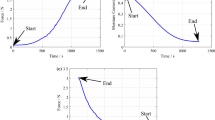Abstract
The environmental scanning electron microscope (ESEM) has the ability to image both dry and hydrated materials, without the need for a conductive coating, unlike conventional SEM. This presents a unique opportunity to explore the structure and dynamic mechanical characteristics of food systems, including those in a moist state. We have developed a technique in which quantitative stress-strain relationships can be obtained whilst allowing simultaneous imaging, by ESEM, of the mechanical response of a sample. The results of in situ compression tests on dry and hydrated wheat flour breadcrumbs are presented and discussed. It was found that a maximum in the critical fracture stress occurred at intermediate moisture content (∼16%). ESEM micrographs demonstrate the differences in mechanical behaviour at three different moisture contents (nominally dry, 16% and 30%). Our findings suggest that 'voids' in cell walls, along with discontinuities between starch granules and gluten in the crumb, play an important role in fracture initiation. Further evidence shows that voids may be bridged by 'struts' and 'strings' of matrix material, which may be factors in the control of fracture propagation.
Similar content being viewed by others
References
H. McGee, “On Food and Cooking. The Science and Lore of the Kitchen.” (Harper Collins, 1991).
T. Shukla, Cereal Foods World 38(9) (1993) 701-702.
L. A. Kuntz, Food Product Design. (April) (1997) 39-56.
R. F. Schiffmann, in “The Technology of Microwavable Coated Foods, in Batters and Breadings in Food Processing,” edited by K. Kulp and R. Loewe (AACC, St. Paul, MN, 1990) p. 153-162.
M. Harris and M. Peleg, Cereal Chemistry 73(2) (1996) 225-231.
G. Attenburrow and A. P. Davies, in “The Glassy State in Foods,” edited by J. M. V. Blanshard and P. J. Lillford (Nottingham University Press, 1993) p. 317-331.
I. Fontanet, S. Dauidou, C. Dacremont and M. Le Meste, J. Cereal Science. 25 (1997) 303-311.
G. Roudaut, C. Dacremont and M. Le Meste,Journal of Texture Studies 29 (1998) 199-213.
Electroscan, Electroscan Model 2010 Manual, 66, Concord Street, Wilmington, MA 01887, USA, 1994.
R. Cameron and A. Donald, J. Microscopy 173(3) (1994) 227-237.
R. Durkin and J. S. Shah, ibid. 169 (1993) 33-51.
B. Thiel et al., ibid. 187(Pt. 3) (1997) 143-157.
A. Fletcher, B. Thiel and A. Donald,J. Phys. D: Appl. Phys. 30 (1997) 2249-2257.
M. Peleg, Food Science and Technology International 3 (1997) 227-240.
G. E. Attenburrow et al., Journal of Cereal Science 16 (1992) 1-12.
R. J. Nicholls et al., ibid. 21 (1995) 25-36.
L. E. Nielsen, “Mechanical Properties of Polymers and Composites” (Marcel Dekker, New York, 1994) Chap. 4.
R. W. Davidge, “Cambridge Solid State Science Series” (Cam-bridge University Press, Cambridge, 1974).
F. C. Chang, J. S. Wu and L. H. Chu,Journal of Applied Polymer Science 44 (1992) 491-504.
J. Vincent, “Structural Biomaterials (Revised Edition)” (Princeton, Princeton University Press, New Jersey, 1990).
L. Gibson and M. Ashby, “Cellular Solids. Structure and Properties” (Pergammon Press, 1998).
T. Alfrey, “Mechanical Behaviour of High Polymers” (Inter-science, 1948).
N. A. J. Platzer, Advances in Chemistry Series, 48 (1965) 23-28.
L. Slade and H. Levine, in “The Glassy State in Foods,” edited by J. M. V. Blanshard and P. J. Lillford (Nottingham University Press, Loughborough, Leics., 1993) p. 35-101.
Author information
Authors and Affiliations
Rights and permissions
About this article
Cite this article
Stokes, D.J., Donald, A.M. In situ mechanical testing of dry and hydrated breadcrumb in the environmental scanning electron microscope (ESEM). Journal of Materials Science 35, 599–607 (2000). https://doi.org/10.1023/A:1004720209547
Issue Date:
DOI: https://doi.org/10.1023/A:1004720209547




